
As surgical techniques continue to advance, surgeons have been able to minimize the effects of extensive scarring. Despite this, scarring is still a possible side effect of undergoing surgery. Fortunately, there are many tips and remedies available that may prevent extensive scarring or improve the appearance of more noticeable scars. Learn more about surgical scarring and how to improve their appearance.
What Are Surgical Scars?
Scarring is possible whenever the skin is damaged or opened, even through a surgical incision. Fortunately, it is possible to reduce the overall extent and severity of scarring following surgery. While some level of scarring is inevitable, scar treatments and proper surgical techniques can minimize the overall extent of scarring.
The extent of surgery is directly related to the incision’s location, the reason for the surgery, your body’s own rate of healing and the surgeon’s overall skill. If a less skilled surgeon performs your surgery, there is a higher risk of developing more severe or noticeable scarring.
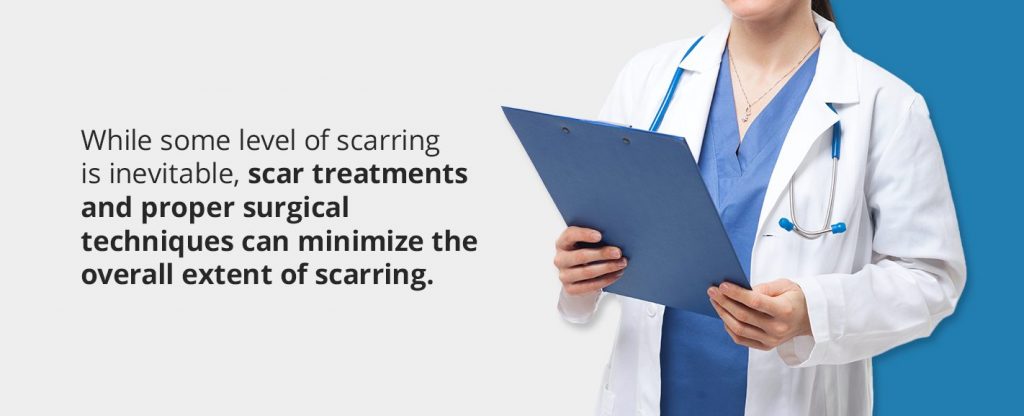
Risk Factors for Scarring
While we all have the potential for scarring after surgery, there are certain risk factors that may increase our risk or extent of scarring, ranging from lifestyle habits to genetics. Some of the most common risk factors that may increase surgical scarring include:
- Age: One aspect that may increase a person’s risk level for surgical scarring is age. As a person ages, their skin loses elasticity and becomes thinner, causing the skin not to heal as well after injury. The effects of old age on scarring are often compounded by sun exposure, pollutants, smoking and other lifestyle factors.
- Race: Certain races may experience a higher risk of scar tissue after surgery. People of African descent may be more likely to experience certain types of scars, including keloid or hypertrophic scars, which are an overgrowth of scar tissue at the injury’s site. The appearance of scars may be more noticeable depending on skin tone.
- Genetics: If your parents or family often develop scars or scars more severely than others, you may have a genetic predisposition to scarring. If you know your family tends to have more noticeable or intense scarring, you should mention this to your physician before any surgery or treatment.
- Incision size and depth: Another important aspect to consider is the incision’s depth and size. Deeper or larger incisions are more likely to leave behind noticeable scarring because it requires a longer healing process. Additionally, larger incisions may be subjected to additional stress when moving, leading to a higher risk of scarring.
- Your individual healing rate: Finally, a person’s individual rate of healing also influences scarring. If you have skin that needs more time to heal, you may be at a higher risk of developing scarring after surgery.

Causes of Surgical Scars
Scars are a normal aspect of the body’s healing process and may occur when the body builds tissue designed to close gaps and repair damaged skin from an injury. While we may think of scars developing from burns, accidents or injuries, surgical incisions are a common cause of scars. Fortunately, most scars tend to fade and improve in appearance over time.
When the skin is punctured or injured, the body produces collagen to reseal open wounds. Collagen plays an essential role throughout the body, protects joints and keeps the skin plump and healthy. When an injury occurs, collagen fibers can repair the broken skin and protect the injury from potential infection.
The causes of surgical scars may vary depending on the type of scar, but some of the most common reasons for surgical scars include:
- Tension on the wound: The amount of stress or tension on a healing incision or wound may increase the severity of scarring. If the incision is made on an area of taught or tight skin, a patient may be more likely to experience scarring.
- Inflammation: Severe or chronic inflammation may increase the risk of developing certain scars, including keloids or hypertrophic scars.
- Skin diseases: Certain skin conditions, including epidermolysis bullosa, a rare group of diseases causing fragile or sensitive skin, may cause scarring to be more likely following surgery or when a wound heals.
- Hypertension: Hypertension is another condition that may cause or increase the risks of hypertrophic or keloid scars following surgery.
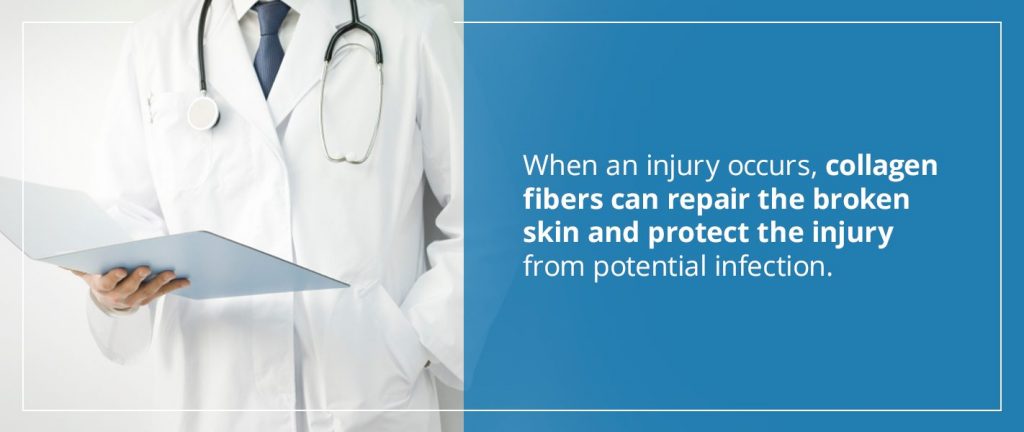
Parts of the Body That Scar Most Easily
Scars develop when fibrous tissues in the deepest layer of skin are damaged, whether through an accident, injury or surgery. While scarring is possible anywhere on the body, there are certain parts of the body that may be more prone to noticeable or pronounced scarring, including:
- Joints: Many people may notice scarring on the knee and elbow joints because they are areas where a large amount of strain or tension is placed on a healing wound. These joints are used in daily life, causing stress on a healing wound and the skin to tighten.
- Upper torso: The upper torso, including the shoulders and chest, may be more likely to experience scarring after surgery. Scarring on the upper torso may be more prominent because there is a higher level of tension in these areas, potentially leading to more pronounced or noticeable scarring.
- Mouth: The mouth harbors many natural bacteria, increasing the potential for infection as a wound or incision heals. An infection in a healing wound negatively impacts the body’s ability to heal and may cause scarring.
- Ears: Ears are another part of your body that may develop more noticeable scarring, especially keloid scars, similar to hypertrophic scarring.
- Legs: Many patients may notice more pronounced scarring on their legs because this skin tends to be tougher than skin elsewhere on the body. Leg scarring may also be more likely to be hypertrophic, meaning the scar is raised and often darker than the surrounding skin.
- Abdomen: Finally, the abdomen is a common place for scarring, and many patients may notice flatter, thinner scars on the abdomen after surgery.

Is Scar Tissue Permanent?
Scar tissue and scars are not inherently permanent and often lighten or improve over time. If a person takes proactive measures when a wound is healing or a scar is just forming, they can often reduce the overall severity of scarring. Scar tissue can undergo a process known as remodeling, where large glumps of cells known as adhesions are loosened and replaced with properly aligned cells.
The process of remodeling can take a few days to multiple years depending on the severity of scarring and extent of the injury or incision that caused the scar to develop in the first place. While some scar tissue may never fully go away, many patients can experience significant improvement in the appearance and movement of their scars by remodeling scar tissue into healthy tissue.

How to Reduce Scarring
It is possible to reduce scarring and improve the appearance of existing scars. The best scar treatment after surgery is often a combination of several treatments, helping to promote your body’s natural healing process and minimize the risk of severe scarring. Follow these 13 tips to help reduce scarring after surgery:
1. Carefully Follow Your Surgeon’s Instructions
One of the most important steps to consider is following your surgeon’s post-operative care instructions to promote healing and minimize scarring. Your surgeon understands what your body needs to heal properly and can tell you what activities you should avoid that cause stress on the incision and may increase your risk of scarring.
You should not partake in rigorous activity, such as running or lifting heavy objects, until your surgeon has cleared you for these activities. Disregarding your surgeon’s post-operative instructions can negatively impact your healing process and may increase your risk of more noticeable scarring.
2. Massage the Scar
Massaging scar tissue around your incisions can help minimize the severity of scarring. While scar massage is effective, you should only perform this once the initial healing state of the skin has occurred, typically one to two weeks after surgery or when suggested by your surgeon. Massaging the incision area in vertical, horizontal and circular motions provides numerous benefits.
Scar massage prevents scar tissue buildup, reduces swelling, drains excess fluids and improves blood flow to the area for tissue remodeling. Other benefits of scar massage include regaining sensation in the area, reducing itchiness, flattening scars for less visibility and increasing scar pliability. When performing scar massage, it is generally recommended to use an unscented lotion or cream.
3. Stay Out of the Sun
Avoiding intense, direct or prolonged sunlight can also reduce the severity of sunscreen. Applying high-quality sunscreen is important to protect the skin if you go outside. You can also protect an incision or healing area of the skin by covering it when you go out in the sun. Avoiding sun during the healing process can encourage healing, reduce swelling and limit severe scarring.
While staying out of the sun is the most effective, you cannot always avoid the sun. If you have to go into the sun, using sunscreen, shielding your incision and covering your body can help protect your skin.
4. Use Sunblock
Sunblock is an important tool for anyone to maintain healthy skin and reduce the negative effects of direct or prolonged sunlight. Sunblock is incredibly useful after surgery to protect delicate, healing skin and minimize scarring. Proper sun protection can reduce discoloration and help a scar fade more quickly. It is generally recommended to use a broad-spectrum sunscreen with a sun protection factor (SPF) of 30 or higher.
You should also regularly reapply sunscreen, especially if you are extended a long time out in the sun. While scars are sensitive in nature, they are especially sensitive for the first year as they heal. Within their first year, scars are also heavily affected by sun exposure.

5. Wear Hats to Cover Your Face
If you have a surgical incision on the face, ears or neck, you may want to wear a hat or visor to protect the incision from direct sunlight. Ultraviolet (UV) radiation can increase bleeding, swelling and irritation of a wound or surgical incision, preventing the area from healing properly and increasing the risk of scarring. While sunblock and minimizing sun exposure are effective, you also want to seek shade regularly.
If you have an incision or healing scar on your head or neck, wearing a broad-brimmed hat or visor can protect healing incisions. Even a small amount of shade can protect a healing incision and lower the dangerous effects of UV radiation and sun exposure.
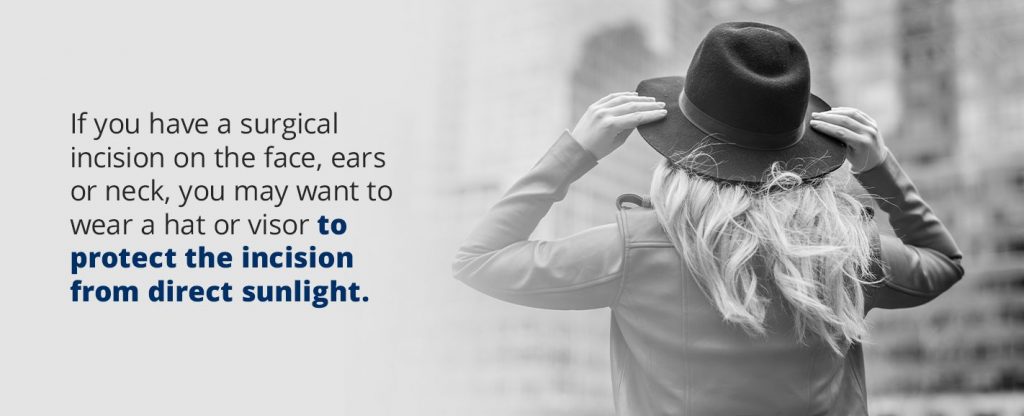
6. Use a Silicone-Based Cream
Silicone-based creams and gels provide numerous benefits for scars, protecting the scar tissue from bacteria and preventing bacteria-induced collagen production. Silicone-based creams may also help alleviate discomfort and itchiness around a scar, allowing the tissue to heal properly. Hydration is important to regulate collagen and fibroblast production, resulting in flatter, softer and less noticeable scars.
Silicone products are among the most effective at-home treatments for numerous scar types, including keloid, hypertrophic and surgical scars. Another benefit of silicone-based creams is they can balance the expression of growth factors, which can cause increased collagen production and worsen scarring. Silicone-based creams can regulate these growth factors and collagen production.
7. Use Vitamin E and Steroids
Vitamin E may help improve wound healing and keep the skin hydrated, enhancing the appearance of scarring. Following surgery, a vitamin E oil or cream can be an excellent way to keep the skin hydrated, promote proper healing and minimize the severity of scarring. Vitamin E also occurs naturally in many foods, including olive oil, whole grains, nuts, sunflower oil, spinach and more.
Topical vitamin E is one of the most popular methods, as it allows people to directly apply a cream or oil to the affected scar tissue, improving hydration.
8. Avoid Pulling
While your incision heals, it is important to minimize pulling and tension on the wound, which contributes to swelling and the potential for scar formation. When there is more pulling or tension, a scar is much more likely to develop or appear more noticeable. Loosening tension and tight scar tissue can be especially beneficial.
Many surgeons recommend scar massages with vitamin E oil or lotion to reduce tension and pulling around the incision. An oil or lotion helps lubricate the skin, reducing friction and tension. Additionally, a lotion or oil helps keep the scar tissue hydrated.
9. Follow Any Exercises Your Surgeon Gives You
Your surgeon may also mention light exercises, such as stretching, to perform after your initial stage of healing. Light stretches and flexibility exercises can help remodel scar tissue and enhance the range of movement. Scar stretches combined with scar massage can be extremely effective at improving the appearance of scars and reducing the overall severity.
Safely stretching scar tissue is an important aspect of post-surgery recovery. Many physical therapists find low-load stretching necessary to remodel scar tissue and promote proper healing. Your surgeon can provide safe stretches to perform and when to start these flexibility exercises.
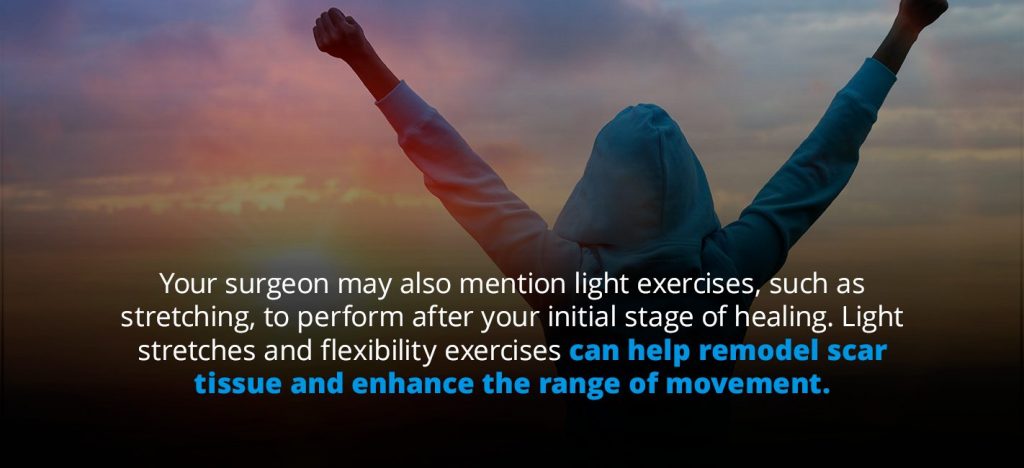
10. Avoid Infections
Scarring is more likely when the body cannot heal a wound or incision effectively. For example, if an incision becomes infected, a scar is much more likely to form. Following post-operative instructions can minimize the risk of infections and help prevent scarring. As a wound or incision heals, you should wash your hands regularly and keep the incision sterile, changing bandages when needed.
A clean and dry wound is much less likely to develop an infection. Antibacterial hand sanitizer is also incredibly useful for sanitizing your hands, especially when outdoors. Quitting smoking can also help minimize the risk of infection and scarring following surgery.
11. Scar Hydration
If an incision has healed and scar tissue has formed, it is essential to keep the scar properly hydrated to minimize the long-term severity of scarring. When you keep a scar hydrated, the scar tissue becomes more flexible, and the scar is less noticeable or severe. The skin around newly formed scars is immature, and it often causes too much water to evaporate from the skin.
The body will sense this loss of moisture and send more collagen to the area to minimize moisture loss. This extra collagen rises above the level of the skin, resulting in raised, lumpy scar. Silicone gel and creams are great to ensure the skin remains hydrated and healthy.
12. Eat Healthy and Maintain a Healthy Weight
Nutrition and weight play important roles in minimizing the severity of scarring after surgery, as well as being essential to overall good health. Vitamins C and A, iron and zinc have all been found to be beneficial to the body and reduce the likelihood of severe scarring. You should also minimize your intake of alcohol and sugars, as these may worsen scarring.
Many nutritionists also recommend reducing your intake of nitrate-rich foods, such as heavily processed and cured meats. Unhealthy nitrate-rich foods may slow healing and build up plaque in the blood vessels. Finally, minimizing caffeine intake can also help reduce the likelihood of post-surgical scarring.
13. Avoid Smoking and Alcohol
Certain lifestyle choices also play a large role in your level of scarring after surgery, including your intake of alcohol and tobacco products. In general, quitting tobacco use and minimizing your alcohol intake are important steps to leading a healthy lifestyle. Alcohol consumption can impede your body’s healing process and worsen scarring.
Additionally, tobacco use and cigarette smoke also delay your body’s ability to form healing tissues and greatly increase the risk of scarring along the border of an incision or wound. The reduced ability for wound repair and scar formation is often a large concern for anyone undergoing surgery.
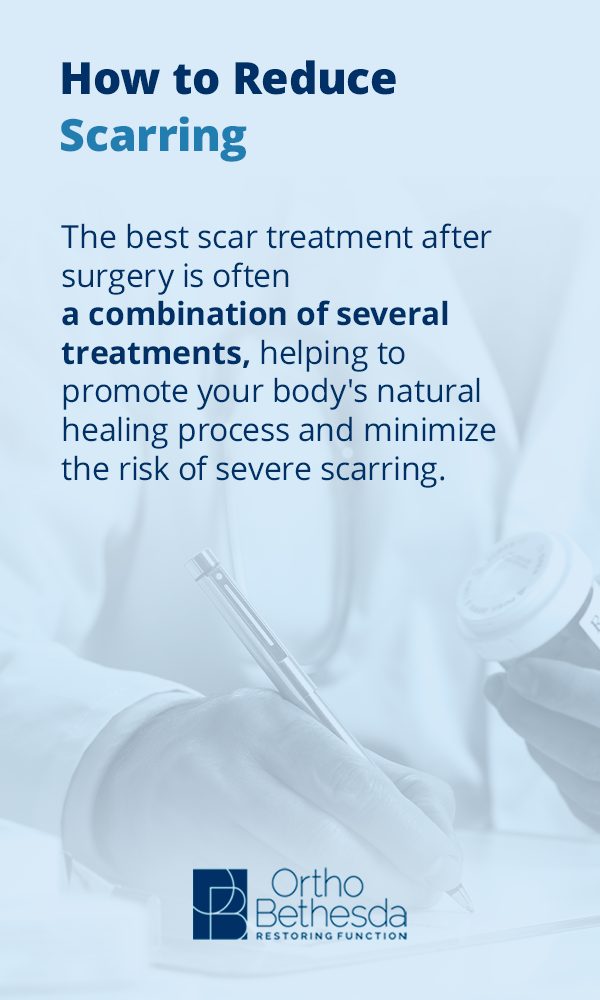
How Your Healthcare Provider Can Help With Scarring
There are numerous treatments and therapies available to reduce scarring and improve existing scars’ size, color and appearance. While some scars may never completely go away, many patients experience success improving the appearance of scars, making them significantly less noticeable. Your healthcare provider can discuss various scar treatments and therapies to improve the appearance of scarring.
- Laser scar removal: Laser scar removal is an innovative treatment using laser technology to reduce the appearance and severity of scars. Light therapy for scars uses focused beams of light energy to gently remove the outer layer of skin and stimulate the creation of new skin cells to replace damaged or unhealthy skin cells. Laser treatments are commonly used to improve various types of scars, including keloids.
- Dermabrasion: Dermabrasion, also known as dermaplaning, is another effective scar treatment that can improve scarring through a process of controlled surgical scraping. Dermabrasion helps remove damaged or unhealthy scar tissue and replace it with healthier, new tissue. Scar dermabrasion can help achieve long-lasting results and smoother skin.
- Scar revision surgery: Scar revision surgery is a procedure that can improve the appearance of an existing scar and make it less noticeable. Scar surgery can improve the cosmetic appearance of a scar while also restoring function to a part of the body that may have been negatively impacted or restricted by a scar.
- Scar pressure therapy: Another beneficial treatment is scar compression therapy that uses gentle pressure to improve scarring. Scar pressure therapy uses flat-knitted compression garments to apply constant pressure along the treatment area. While compression therapy is often used for newly healing incisions, it can also improve older scars.
Discuss Surgical Scarring With OrthoBethesda Today
While scarring is always possible, the team at OrthoBethesda is dedicated to minimizing scarring and using the latest and most innovative surgical techniques. orthopedic surgeons are highly trained experts and board-certified physicians who provide comprehensive orthopedic care to patients in Virginia and the surrounding areas.
Our orthopedic surgeons can assess, diagnose and treat orthopedic conditions affecting the elbow, hand, wrist, hip, knee, shoulder and spine. All of our physicians are fellowship-trained and experts in their specialty and are well-respected members of the medical community.
Learn more about our orthopedic treatments and surgeries and contact us online today.
